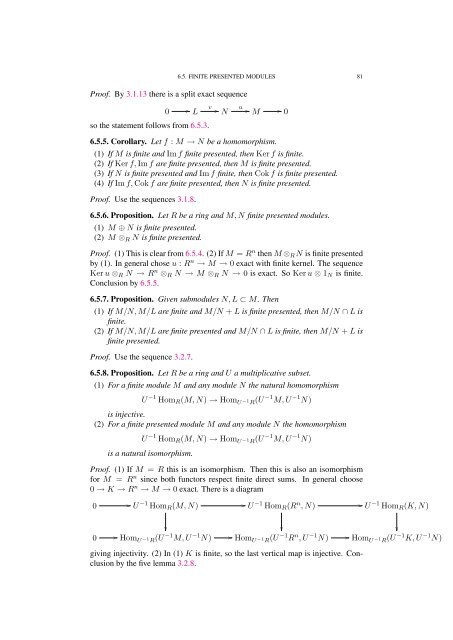Commutative algebra - Department of Mathematical Sciences - old ...
Commutative algebra - Department of Mathematical Sciences - old ...
Commutative algebra - Department of Mathematical Sciences - old ...
You also want an ePaper? Increase the reach of your titles
YUMPU automatically turns print PDFs into web optimized ePapers that Google loves.
Pro<strong>of</strong>. By 3.1.13 there is a split exact sequence<br />
so the statement follows from 6.5.3.<br />
0<br />
6.5. FINITE PRESENTED MODULES 81<br />
<br />
v<br />
L <br />
u<br />
N <br />
M<br />
6.5.5. Corollary. Let f : M → N be a homomorphism.<br />
(1) If M is finite and Im f finite presented, then Ker f is finite.<br />
(2) If Ker f, Im f are finite presented, then M is finite presented.<br />
(3) If N is finite presented and Im f finite, then Cok f is finite presented.<br />
(4) If Im f, Cok f are finite presented, then N is finite presented.<br />
Pro<strong>of</strong>. Use the sequences 3.1.8.<br />
6.5.6. Proposition. Let R be a ring and M, N finite presented modules.<br />
(1) M ⊕ N is finite presented.<br />
(2) M ⊗R N is finite presented.<br />
Pro<strong>of</strong>. (1) This is clear from 6.5.4. (2) If M = R n then M ⊗R N is finite presented<br />
by (1). In general chose u : R n → M → 0 exact with finite kernel. The sequence<br />
Ker u ⊗R N → R n ⊗R N → M ⊗R N → 0 is exact. So Ker u ⊗ 1N is finite.<br />
Conclusion by 6.5.5.<br />
6.5.7. Proposition. Given submodules N, L ⊂ M. Then<br />
(1) If M/N, M/L are finite and M/N + L is finite presented, then M/N ∩ L is<br />
finite.<br />
(2) If M/N, M/L are finite presented and M/N ∩ L is finite, then M/N + L is<br />
finite presented.<br />
Pro<strong>of</strong>. Use the sequence 3.2.7.<br />
6.5.8. Proposition. Let R be a ring and U a multiplicative subset.<br />
(1) For a finite module M and any module N the natural homomorphism<br />
<br />
0<br />
U −1 HomR(M, N) → Hom U −1 R(U −1 M, U −1 N)<br />
is injective.<br />
(2) For a finite presented module M and any module N the homomorphism<br />
U −1 HomR(M, N) → Hom U −1 R(U −1 M, U −1 N)<br />
is a natural isomorphism.<br />
Pro<strong>of</strong>. (1) If M = R this is an isomorphism. Then this is also an isomorphism<br />
for M = R n since both functors respect finite direct sums. In general choose<br />
0 → K → R n → M → 0 exact. There is a diagram<br />
0<br />
0<br />
<br />
U −1 HomR(M, N)<br />
<br />
<br />
HomU −1R(U −1M, U −1N) <br />
U −1 HomR(R n , N)<br />
<br />
<br />
HomU −1R(U −1Rn , U −1N) giving injectivity. (2) In (1) K is finite, so the last vertical map is injective. Conclusion<br />
by the five lemma 3.2.8.<br />
<br />
U −1 HomR(K, N)<br />
<br />
<br />
HomU −1R(U −1K, U −1N)
















